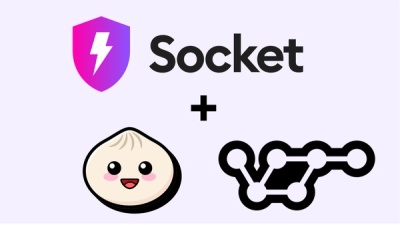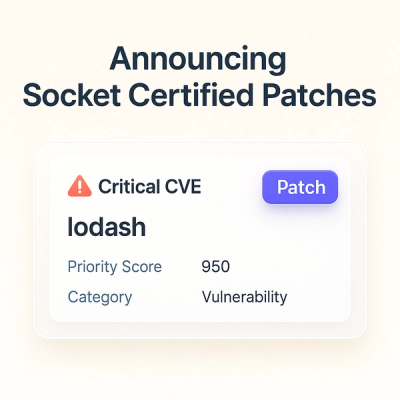
Product
Announcing Bun and vlt Support in Socket
Bringing supply chain security to the next generation of JavaScript package managers

goa is a framework for building microservices in Go using a unique design-first approach.
There are a number of good Go packages for writing modular web services out there so why build another one? Glad you asked! The existing packages tend to focus on providing small and highly modular frameworks that are purposefully narrowly focused. The intent is to keep things simple and to avoid mixing concerns.
This is great when writing simple APIs that tend to change rarely. However there are a number of problems that any non trivial API implementation must address. Things like request validation, response media type definitions or documentation are hard to do in a way that stays consistent and flexible as the API surface evolves.
goa takes a different approach to building these applications: instead of focusing solely on helping with implementation, goa makes it possible to describe the design of an API in an holistic way. goa then uses that description to provide specialized helper code to the implementation and to generate documentation, API clients, tests, even custom artifacts.
The goa design language allows writing self-explanatory code that describes the resources exposed
by the API and for each resource the properties and actions. goa comes with the goagen tool which
runs the design language and generates various types of artifacts from the resulting metadata.
One of the goagen output is glue code that binds your code with the underlying HTTP server. This
code is specific to your API so that for example there is no need to cast or "bind" any handler
argument prior to using them. Each generated handler has a signature that is specific to the
corresponding resource action. It's not just the parameters though, each handler also has access to
specific helper methods that generate the possible responses for that action. The metadata can also
include validation rules so that the generated code also takes care of validating the incoming
request parameters and payload prior to invoking your code.
The end result is controller code that is terse and clean, the boilerplate is all gone. Another big benefit is the clean separation of concern between design and implementation: on bigger projects it's often the case that API design changes require careful review, being able to generate a new version of the documentation without having to write a single line of implementation is a big boon.
This idea of separating design and implementation is not new, the excellent Praxis framework from RightScale follows the same pattern and was an inspiration to goa.
If you are new to goa I can't recommend enough that you read the Gopher Academy blog post. goa may look a little bit different at first, the post explains the thinking behind it so that you can better take advantage of the framework.
Assuming you have a working Go setup:
go get github.com/goadesign/goa
go get github.com/goadesign/goa/goagen
Create the file $GOPATH/src/goa-adder/design/design.go with the following content:
package design
import (
. "github.com/goadesign/goa/design"
. "github.com/goadesign/goa/design/apidsl"
)
var _ = API("adder", func() {
Title("The adder API")
Description("A teaser for goa")
Host("localhost:8080")
Scheme("http")
})
var _ = Resource("operands", func() {
Action("add", func() {
Routing(GET("add/:left/:right"))
Description("add returns the sum of the left and right parameters in the response body")
Params(func() {
Param("left", Integer, "Left operand")
Param("right", Integer, "Right operand")
})
Response(OK, "text/plain")
})
})
This file contains the design for an adder API which accepts HTTP GET requests to /add/:x/:y
where :x and :y are placeholders for integer values. The API returns the sum of x and y in
its body.
Now that the design is done, let's run goagen on the design package:
$ cd $GOPATH/src/goa-adder
$ goagen bootstrap -d goa-adder/design
This produces the following outputs:
main.go and operands.go contain scaffolding code to help bootstrap the implementation.
running goagen again does no recreate them so that it's safe to edit their content.app package which contains glue code that binds the low level HTTP server to your
implementation.client package with a Client struct that implements a AddOperands function which calls
the API with the given arguments and returns the http.Response. The client directory also
contains the complete source for a client CLI tool (see below).swagger package with implements the GET /swagger.json API endpoint. The response contains
the full Swagger specificiation of the API.First let's implement the API - edit the file operands.go and replace the content of the Add
function with:
// Add runs the add action.
func (c *OperandsController) Add(ctx *app.AddOperandsContext) error {
sum := ctx.Left + ctx.Right
return ctx.OK([]byte(strconv.Itoa(sum)))
}
Now let's compile and run the service:
$ cd $GOPATH/src/goa-adder
$ go build
$ ./goa-adder
2016/04/05 20:39:10 [INFO] mount ctrl=Operands action=Add route=GET /add/:left/:right
2016/04/05 20:39:10 [INFO] mount file name=swagger/swagger.json route=GET /swagger.json
2016/04/05 20:39:10 [INFO] listen transport=http addr=:8080
Open a new console and compile the generated CLI tool:
cd $GOPATH/src/goa-adder/client/adder-cli
go build
The tool includes contextual help:
$ ./adder-cli --help
CLI client for the adder service
Usage:
adder-cli [command]
Available Commands:
add add returns the sum of the left and right parameters in the response body
Flags:
--dump[=false]: Dump HTTP request and response.
-H, --host="localhost:8080": API hostname
--pp[=false]: Pretty print response body
-s, --scheme="http": Set the requests scheme
-t, --timeout=20s: Set the request timeout, defaults to 20s
Use "adder-cli [command] --help" for more information about a command.
To get information on how to call a specific API use:
$ ./adder-cli add operands --help
Usage:
adder-cli add operands [/add/LEFT/RIGHT] or [flags]
Flags:
--left int Left operand
--right int Right operand
Global Flags:
--dump Dump HTTP request and response.
-H, --host string API hostname (default "localhost:8080")
--pp Pretty print response body
-s, --scheme string Set the requests scheme
-t, --timeout duration Set the request timeout (default 20s)
Now let's run it:
$ ./adder-cli add operands /add/1/2
2016/04/05 20:43:18 [INFO] started id=HffVaGiH GET=http://localhost:8080/add/1/2
2016/04/05 20:43:18 [INFO] completed id=HffVaGiH status=200 time=1.028827ms
3⏎
This also works:
$ ./adder-cli add operands --left=1 --right=2
2016/04/25 00:08:59 [INFO] started id=ouKmwdWp GET=http://localhost:8080/add/1/2
2016/04/25 00:08:59 [INFO] completed id=ouKmwdWp status=200 time=1.097749ms
3⏎
The console running the service shows the request that was just handled:
2016/04/05 20:43:18 [INFO] started action=Add id=cASjgqGiCP-1 GET=/add/1/2
2016/04/05 20:43:18 [INFO] params action=Add id=cASjgqGiCP-1 right=2 left=1
2016/04/05 20:43:18 [INFO] completed action=Add id=cASjgqGiCP-1 status=0 bytes=0 time=36.615µs
Now let's see how robust our service is and try to use non integer values:
./adder-cli add operands add/1/d
2016/04/05 20:44:56 [INFO] started id=5254tL8j GET=http://localhost:8080/add/1/d
2016/04/05 20:44:56 [INFO] completed id=5254tL8j status=500 time=840.12µs
error: 500: "Internal error: 400 invalid_request: invalid value \"d\" for parameter \"right\", must be a integer"
As you can see the generated code validated the incoming request against the types defined in the design.
The swagger directory contains the entire Swagger specification in the swagger.json file. The
specification can also be accessed through the service:
$ curl localhost:8080/swagger.json
For open source services hosted on github swagger.goa.design provides a free service that renders the Swagger representation dynamically from goa design packages.
http://goa.design contains further information on goa including a getting started guide, detailed DSL documentation as well as information on how to implement a goa service.
The examples repo contains simple examples illustrating basic concepts.
The goa-cellar repo contains the implementation for a goa service which demonstrates many aspects of the design language. It is kept up-to-date and provides a reference for testing functionality.
Did you fix a bug? write docs or additional tests? or implement some new awesome functionality?
You're a rock star!! Just make sure that make succeeds (or that TravisCI is green) and send a PR
over.
The issues contain entries tagged with help wanted: beginners which provide a great way to get started!
FAQs
Unknown package
Did you know?

Socket for GitHub automatically highlights issues in each pull request and monitors the health of all your open source dependencies. Discover the contents of your packages and block harmful activity before you install or update your dependencies.

Product
Bringing supply chain security to the next generation of JavaScript package managers

Product
A safer, faster way to eliminate vulnerabilities without updating dependencies

Product
Reachability analysis for Ruby is now in beta, helping teams identify which vulnerabilities are truly exploitable in their applications.